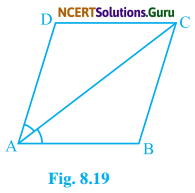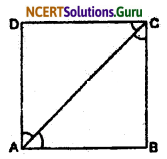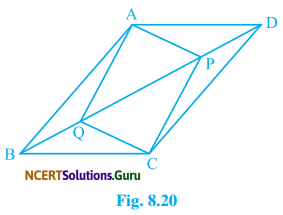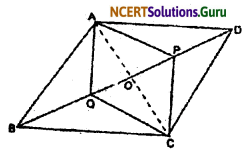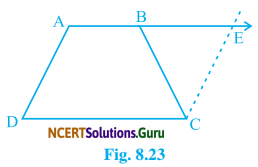NCERT Solutions for Class 9 Maths Chapter 9 Areas of Parallelograms and Triangles Ex 9.2
These NCERT Solutions for Class 9 Maths Chapter 9 Areas of Parallelograms and Triangles Ex 9.2 Questions and Answers are prepared by our highly skilled subject experts.
NCERT Solutions for Class 9 Maths Chapter 9 Areas of Parallelograms and Triangles Exercise 9.2
Question 1.
In fig. 9.15, ABCD is a parallelogram and AE ⊥ DC and CF ⊥ AD. If AB = 16 cm, AE = 8 cm and CF = 10 cm. Find AD.

Solution:
In this fig. we have given AB = 16 cm, AE = 8 cm, CF = 10 cm and ABCD is a parallelogram.
∴ AB = CD (opp side of parallelogram)
∴ CD = 16 cm
Again we know that,
Area of parallelogram = Base × Corresponding altitude
∴ Area of parallelogram ABCD = CD × AE
= 16 × 8
= 128 cm2 …..(i)
Again Area of parallelogram = AD × CF
128 = AD × 10 (from equ. (i))
AD = \(\frac{128}{10}\) = 12.8 cm
AD = 12.8 cm
![]()
Question 2.
If E, F, G and H are respectively the mid points of the sides of a parallelogram ABCD. show that ar(EFGH) = \(\frac {1}{2}\) ar(ABCD).
Solution:
Given: ABCD is a parallelogram, in which E, F, G, and H are the midpoints of sides AB, BC, CD, and AD respectively.

To prove that
ar(||gm EFGH) = \(\frac {1}{2}\) ar (||gm ABCD)
Construction: Join HF
Proof: ABCD is a ||gm
∴ AD || BC and AD = BC
∴ AH = BF and AH || BF
Therefore, ABFH is a ||gm.
Since, ∆HEF and || gm HABF are on the same base HF and between the same parallel lines, AB and HF
∴ ar(∆HEF) = \(\frac {1}{2}\) ar(||gm HABF) …….(i)
Similarly, ∆HGF and ||gm HDCF are on same base HF and between the same parallel lines, DC and HF.
∴ ar (∆HGF) = \(\frac {1}{2}\) ar (|| gm HDCF) …….(ii)
Adding (i) and (ii) we get
ar(∆HEF) + ar(∆HGF)
= \(\frac {1}{2}\) ar(|| gm HABF) + \(\frac {1}{2}\) ar(||gm HDCF) + ar (|| gm FFGH)
= \(\frac {1}{2}\) [ar(||gm HABF) + ar (||gm HDCF)]
or, ar (||gm EFGH) = \(\frac {1}{2}\) ar (|| gm ABCD)
![]()
Question 3.
P and Q are any two points lying on the sides DC and AD respectively of a parallelogram ABCD shows that ar(∆APB) = ar(∆BQC).
Solution:
Given: ABCD is a || gm in which P and Q are the points on side DC and AD respectively.
To prove that: ar(∆APB) = ar(∆BQC)
Proof: ABQC and || gm ABCD lie on the same base BC and between the same parallel lines.

∴ ar (∆BQC) = \(\frac {1}{2}\) ar(||gm ABCD) ……(i)
Similarly, ∆APB and ||gm ABCD lie on the same base AB and between same parallel lines.
∴ ar(∆APB) = \(\frac {1}{2}\) ar (||gm ABCD) ……(ii)
From equation (i) and (ii), we can say
ar(∆BQC) = ar(∆APB)
![]()
Question 4.
In fig. 9.16, P is a point in the interior of a parallelogram ABCD. Show that
(i) ar(∆APB) + ar(∆PCD) = \(\frac {1}{2}\) ar (||gm ABCD)
(ii) ar(∆APD) + ar(∆PBC) = ar(∆APB) + ar(∆PCD)

Solution:
Given: ABCD is a || gm in which P is any point interior to it.
To prove that:
(i) ar(∆APB) + ar(∆PCD) = \(\frac {1}{2}\) ar (||gm ABCD)
(ii) ar (∆APD) + ar(∆PBC) = ar(∆APB) + ar(∆PCD)

Construction: Through P draw a line parallel to AB which interacts with AD at M and BC at N.
Proof: In parallelogram ABCD,
AB || CD (opp sides of a ||gm)
But, AB || MN (by construction)
∴ MM || CD
In ABNM
AB || MN and AM || BN (opp sides of || gm)
∴ ABNM is a || gm
Again, ∆APB and || ABNM lie on the same base AB and between the same parallel lines AB and MN.
∴ ar (∆APB) = \(\frac {1}{2}\) ar (|| gm ABNM) ……(i)
Similarly, MNCD is a parallelogram.
Since ∆PCD and || gm MNCD lie on same base CD and between same parallel lines CD and MN.
Therefore, ar (∆PCD) = \(\frac {1}{2}\) ar (|| gm MNCD) ……(ii)
Adding (i) and (ii) we get,
ar(∆APB) + ar(∆PCD) = \(\frac {1}{2}\) [ar (|| gm ABNM) + ar (|| gm MNCD)]
∴ ar(∆APB) + ar(∆PCD) = \(\frac {1}{2}\) [ar (|| gm ABCD) ……(iii)
(ii) Similarly, itive draw a line through P and parallel to D.
Then, ar(∆APD) + ar(∆PBC) = \(\frac {1}{2}\) ar (|| gm ABCD) ……(iv)
From equation (iii) and (iv) we can say
ar(∆APP) + ar(∆PBC) = ar(∆APB) + ar(∆PCD)
![]()
Question 5.
In fig. 9.17, PQRS and ABRS are parallelograms and X is any point on side BR. Show that
(i) ar (|| gm PQRS) = ar (|| gm ABRS)
(ii) ar (∆AXS) = \(\frac {1}{2}\) ar (|| gm PQRS)

Solution:
Parallelograms PQRS and ABRS are lying on the same base SR and in between the same parallel lines SR and PB.

We know that parallelograms lie on the same base and between the same parallel lines are equal in area,
∴ ar(|| gm PQRS) = ar(|| gm ABRS) ……(i)
(ii) Again, ∆AXS and || gm ABRS lie on the same base AS and between the same parallel lines AS and BR.
∴ ar (∆AXS) = \(\frac {1}{2}\) ar (|| gm ABRS)
or, ar (∆AXS) = \(\frac {1}{2}\) ar (|| gm PQRS) (from equ. (i))
![]()
Question 6.
A farmer was having a field in the form of a parallelogram PQRS. She took any point A on RS and joined it to point P and Q. In how many parts the field is divided? What is the shape of these parts? The fanner wants to saw wheat and pulses in equal portions of the field separately. How should she do it?
Solution:
According to the question, fields is divided into three-part. The shape of the three parts is triangular as ∆PSA, ∆PAQ, and ∆QRA.

Again, according to the question, the farmer wants to sow wheat and pulses in an equal portion of the field separately.
We know that if a parallelogram and triangle are on the same base and between the same parallels, then the area of the triangle is half the area of the parallelogram.
∴ ar(∆PAQ) = \(\frac {1}{2}\) ar (|| gm PQRS)
or, ar(∆PAQ) = ar(∆PSA) + ar(∆QRA)
So, farmers must sow wheat in triangular parts PAQ and pluses in other two triangular parts PSA and QRA, or, pulses in triangular parts PAQ and wheat in other two triangular parts PSA and QRA.
NCERT Solutions for Class 9 Maths Chapter 9 Areas of Parallelograms and Triangles Ex 9.2 Read More »











